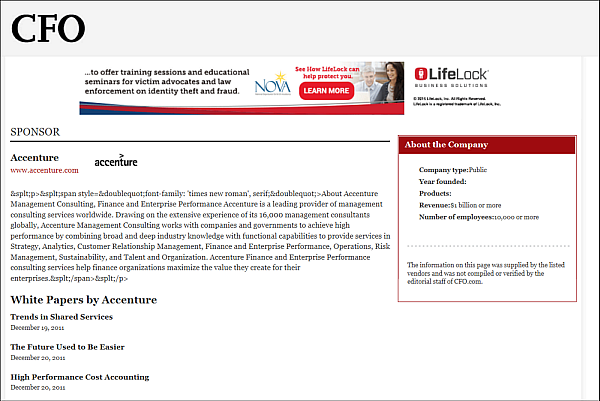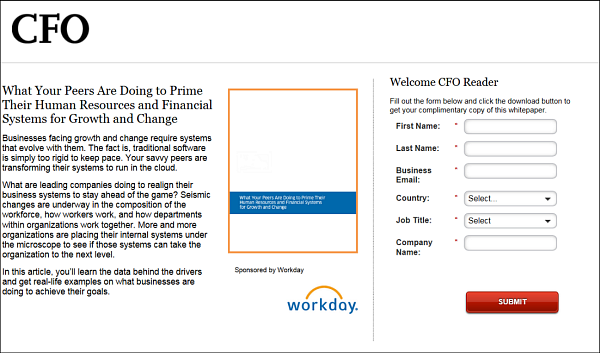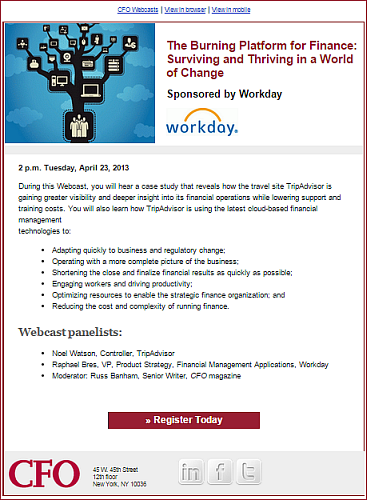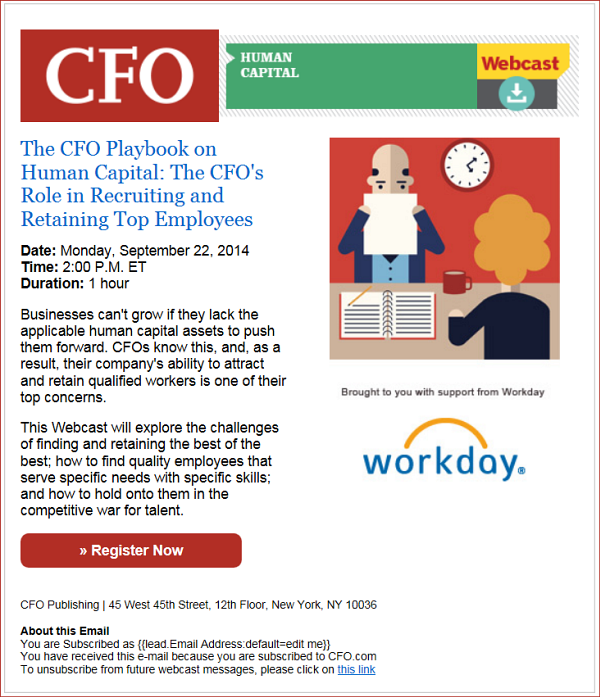by
Courtney Eckerle, Manager of Editorial Content
THE CUSTOMER
"CFO started off as just a magazine ... we're actually celebrating 30 years this year. CFO was the first B2B publication focusing on a specific functional role. There are not many finance function magazines out there, so we're really unique," Danielle Balestra, Director of Marketing and Audience Development, CFO Publishing, said.
CFO Publishing is a leading voice in enterprise information and innovation. It provides thought leadership content that reaches senior finance and business executives across seven channels, including finance, big data, analytics, strategy, innovation, digital and operations.
In addition to content channels, CFO also produces live conferences and summits, on-demand video content, webcasts, white papers, lead generation services, custom events and custom research.
"We’ve been really innovative in using a lot of technologies to distribute content to our readers in the format that they want. It could be on the website — we have a responsive website. It could be through events. It could be through our print magazine or ... our tablet edition or our digital edition. So we're really, in my opinion, very innovative for a B2B organization," she said.
CHALLENGE
"My role here has changed quite a bit since I started. I've been here about three years now. I started off just working on our product development team and marketing those products ... I've evolved to now managing the full audience development and marketing team," Balestra said.
This effort began when Balestra took over the role in 2013. There were some issues with the marketing structure at the time.
"We just needed to move all of our audience data in-house, and we wanted to manage it in a more holistic way," she said.
Originally, CFO was operating like a traditional publication in that its data was managed by a circulation house with any dot-com users being managed in-house.
Balestra and her team felt that this wasn’t how CFO should operate and, instead, moved all the data to one place. The issue with that decision was "the internal infrastructure did not provide visibility into our data and made it harder to operate. My position was to quickly find the right infrastructure that would provide us the visibility into our consumer data we still lacked — our strategy of identifying segments to send relevant thought leadership pieces depended on this," she said.
Being a big believer in understanding behaviors based off of analytics, Balestra wanted to use analytics to make adjustments to the marketing strategy as well as to distribute relevant content to users.
"The previous structure didn't provide behavioral analytics and we had to find a new infrastructure that could," she said.
CAMPAIGN
To help with CFO’s database, email and analytics, the team moved all of their consumer data into one vendor system.
"It was amazing to see the visibility right away ... We were able to start putting some ... what they call 'governors' in place to make sure we didn't oversend to certain users," Balestra said.
Balestra was also able to use automation to present relevant content without having to actually send customers an email. Using downloaded landing pages to populate content was a logical next step.
"We were sending a lot of email in 2013. Having the visibility into our sending analytics, we were able to hugely decrease the amount of sends," she said.
The team was also able to identify data point issues that they were having. This included information being incorrect because people were self-reporting. "When it comes to your revenue, you might not actually know your true revenue. So somebody might report the company revenue as ... a range of $100 million to $500 million, but really they might be a billion plus," Balestra said.
Balestra said she has listened to a lot of "marketing theory in the past couple of years saying, 'You have to be able to segment. You have to be able to send relevant content to relevant people.' And you only really can do that when you make sure your data is ... clean."
The most exciting part of this campaign has been being "able to execute all of these theories and to see the results actually work. So I think having the right technology and clean data is the whole gist of it in a very quick summary," she said.
Step #1. Enact data changes
"We started to really clean up the consumer information, and we also started filling in any gaps," she said, explaining that, depending on how someone comes into the database, they might not have a complete mailing address or profile.
Because CFO has so many instances of gathering information for different people at one organization, there is a large group of people where "we can actually normalize that data off of an applied theory that, if this many people from one organization show up with a majority of them having this data point, then [we can] apply it to all other people from that organization," Balestra said.
The team executed a lot of data cleanup and was able to do more specific segmentation. This included, for example, regional marketing for specific events.
"We can actually now target a bigger pool where we might have had data missing in the past," she said.
Previously, the system was extremely manual and segmentation was difficult and confusing, she said. Email execution was essentially batch-and-blast.
"We tried to export lists of people [who had] previously downloaded an asset, built a list of all similar assets and sort of import them back into the system. But all this manual work wasn't being very useful," she said.
After the data was fully integrated into the system, "we identified and categorized the areas that we wanted to go through ... we knew what we wanted to do for all our thought leadership. Our ebooks were in one section, our white papers were in another and our webcasts were in another," she said.
From there, Balestra said her team understood how to structure and build a segmented campaign.
"Everything had assets, which would be the actual email templates, the landing pages, the forms that go to the landing pages, the reports that we would provide to maybe our sponsors or for us to know who downloaded. And then how that all connected back into the analytics side ... we can run monthly reports on volume sends, open rates or easy click rates," she said.
Step #2. Create new landing page form fields
CFO also began using new landing pages, transferring over from
the old CMS, which was "really not built for a lot of thought leadership products," Balestra said.

Click here to see the full version of this creative sample
Thought leadership products for CFO are ebooks, webcasts, white papers and research reports.
"A lot of the information that appeared on that landing page for the ebook did not apply. It didn't make sense. The terminology, such as 'underwriter,' was just strange. The form was too long and it was multiple steps," she said.
The
new landing page gives the team two new abilities. First, when visitors fill out the form, the system tags them with that topic. This allowed the team to send users relevant emails about topics they’ve expressed interest in. The team can also now change the form at will, without development resources. With the help of a third party form shortening service, this allowed them to shorten the form to five fields.

Click here to see the full version of this creative sample
"Then we were applying all the rest of the data back into the system through hidden fields. So that helped improve the conversion," Balestra said.
With the flexibility to change the form, the team began A/B testing elements such as text length and image size.
After downloading a piece of content, CFO began offering relevant content — based off of that previous download — and integrating it into the landing page. For example, if someone downloaded an ebook on accounting law and there is a relevant webcast coming up, it is populated into the download page. Someone can sign up at the same time instead of having to wait for the informational email.
"We see in our daily reports these little one-off confirmation emails that people signed up for things after they downloaded something else. So all of this integration helps turn programs and campaigns around that would have failed over a year ago. And the improvements are just amazing," she said.
Just by segmenting this data, the team saw an open rate improvement of 205% for thought leadership content, Balestra added.
Step #3. Understand the customer's journey
If a customer begins by downloading a technology brief, such as an ebook called "Rethinking Tax Technology," Balestra said, the team knows that the customer is interested not only in tax, but also technology information.
"Immediately after that download — if we know that you have never signed up for a CFO newsletter — in two days, you're going to get an automatic email saying, 'Please sign up for CFO Weekly,'" she said.
As soon as they have downloaded the tech content, on the download confirmation page is the "Related Content" block that will suggest an immediate download of, for example, a related white paper on tax or technology.
In two days, the customer is going to be sent an email to sign up for the CFO newsletter, and customers who do are automatically in the pool for any additional promotions. Based off of the information CFO has — for instance, that the customer is interested in tax and technology — they will be sent that type of information moving forward.
Balestra’s team is also pulling information from the website about the customer’s activity, adding to the customer’s profile not only that they’ve downloaded content but that they have also been visiting the CFO tax column area.
This gradual build-up of data based on a customer’s journey, and scaling of email sends because of it, has allowed CFO to only send to customers when there is content relevant to them.
"Throughout the rest of the year, you might get a few [emails] a week. You might get no emails coming in because there might not be really relevant content for you in that time period," she said, adding that the most emails a customer can possibly get in a day from CFO is limited to two.
Step #4. Build out segmentation
On the previous system, Balestra and her team had essentially
been batch-and-blasting email sends. They wanted to segment "in the worst way possible, but it just was not possible in the system we were in. We didn't have all of the data about the use activity there."

Click here to see the full version of this creative sample
Because most of the data on customer activity was held in a different database, there was no connection or clear picture of the customer journey to work from.
"Even trying to build those data points into the email service provider we were using previously ... it required a full development team and it required certain API calls that were just very time-consuming," she said.
Once this effort housed all data points in one place, "we were able to do those segmentations in a very easy way," she said.
The team began segmenting immediately, and for
new sends, people were sorted based on interests and actions, such as whether or not they had opted out of conference information or downloaded a certain piece of content.

Click here to see the full version of this creative sample
"Entering demographics such as company size, and that they're interested in tech or opened an email in the last three months or last 30 days ... so we know that they're currently very engaged with our community," Balestra said.
Currently, the team has 27 segments, Balestra said, adding that "we keep adjusting them based off some other criteria that might show up. So we [segment] by topics [and] we [segment] by content delivery."
Going into marketing automation after doing batch-and-blast for so long "is a scary place, because the software provides you a lot of functionality, and if you don't know where to start, it's very scary," she said.
Segmentation and automation can become complicated very quickly, she added, but "we understood that going in. So once we figured out just email segmentations, then we realized, you know what? There's more stuff we can use here, and let's use it."
Her team has been able to focus on building nurturing campaigns and sketching out the different customer journeys that will lead to different buckets.
In spite of the complicated nature of this switch, the important thing, according to Balestra, is in "understanding [that] you need to tackle the basics first and then keep getting more sophisticated as you go. Just to keep fine-tuning it."
Step #5. Check metrics of every email
From all of those 27 segments, Balestra and her team "check every email that we're sending and the landing pages … so we know how well programs are going. We sort of baseline our conversion rates. And then anything below a certain level, we make major adjustments to make sure the campaign improves."
They also monitor the volume of emails sent per topic and, if it reaches a certain number, the team stops the sends to review the content and email structure. They then identify any fresh content that can be added, or a different audience that could be targeted.
The final piece, she said, is the overall analytics of the email program.
"We will look at everything during the month and make sure everything is staying on its baseline or climbing up," she said.
Since the transition, the team has stayed vigilant over open, clickthrough, download, conversion and unsubscribe rates.
"We measure all these things. We watch. We have alerts anytime something's starting to go awry or not well. And then we have an immediate meeting to review all the content pieces and what exactly was executed, and make sure we can make adjustments to improve promotions," she said.
An important element has been the ability of the team to stay nimble and notice trends — positive or negative — and adjust based off of those observations.
RESULTS
From the previous batch-and-blast system, CFO Publishing has seen:
- 205% open rate increase for thought leadership emails
- 78% clickthrough rate increase
- 35% increase in downloads or registrations for thought leadership programs
- 37% decrease in email promotions deployed
"Again, being able to segment those email sends is critical ... as well as having the data to back that up ... When you actually put segmentation marketing in practice, it's amazing to see it happen," Balestra said.
Most marketers, she added, are constantly "trying to find that silver bullet of marketing success, how do you improve campaign successes." The key is in paying attention to your systems and constantly improving to ensure that customers are getting relevant content.
For instance, the team has been able to decrease sends because of increased relevancy so they aren’t sending "irrelevant content to people that don’t want it," she said.
"It's easier to lose somebody than to gain someone. It takes much more effort to get somebody interested. But once you get them engaged and you keep giving them relevant content, it's much easier to operate," she concluded.
Creative Samples
- Previous landing page
- Current landing page
- Previous email
- Current email
Sources
CFO PublishingMarketo Related Resources
Email Marketing Segmentation: Clothing brand uses social behavioral data to drive a 141% increase in revenueEmail Segmentation: 40% average open rate via relevant content journey Email Marketing Research Chart: Why subscribers flag email as spamEmail Segmentation: Finish Line's automation initiative lifts email revenue 50%Email Marketing: How content and testing boosted revenue 114% at IAC subsidiary HomeAdvisor













